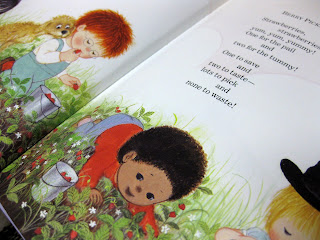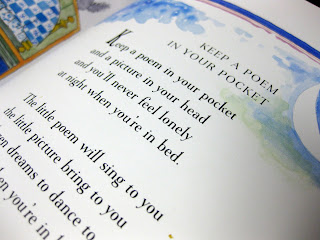![]()

Lately, we’ve been so busy. May flew by, like it always does for us–a blur of end-of-school activities, yard work, picnics, park dates, and now pool time.
So I’ve tried to sneak in what I can, when I can. Most of our learning has been happening through read-alouds, either our newspaper reading at breakfast, or during books at bedtime or before rest time. And believe me, I’m not downplaying it–there’s tons that can be done during those small bits of reading time, and really, there’s not a lick of prep or clean-up involved. Woo-hoo!
And seriously, kids don’t even need to know how to read in order for parents to start teaching reading comprehension strategies; all the parents need are some easy tools up their sleeve.
I’ve been trying to focus on making connections with Owen and Cora:
- Reading Comprehension Strategy–Making Connections: We always seem to go on poetry-kicks around here, and we’re on one now. Owen, Cora, and I have been reading our favorite poetry books before rest time most days because the poems are short and catchy, and they’re beginning to say them along with me. (And memorizing is super for little brains!)
So what I’ve been trying to do as we read is simply model how a person makes connections with a text. Nothing crazy, nothing fancy, nothing super-wild. I’ll read a poem like “Berry Picking” from Bobbi Katz’s Poems for Small Friends (1989) and say, Oh I cannot wait to go strawberry picking this summer. It’s so hard to put those strawberries in our buckets without eating them, especially when they’re so red and ripe like the ones in this picture. Yum.
Making connections is so easy, but it is muy importante
for emerging readers.And maybe we’ll chat a little about what we remember from last summer’s strawberry picking at the farm. Just a minute or two–or if they really want to talk, we’ll talk more. Not a big deal. But the time it takes for me to show Owen and Cora that I (and they) have a personal connection to this poem will help them to remember it. It will help them to understand it better, and it will help them to begin making connections to the texts they read (or books they look at) when I’m not there. And making connections is something that all strong readers do naturally.
Because these are rich texts filled with super poetry, I could demonstrate some sort of connection–either to myself, to some other poem we’ve read, or to something in the world around us–for every poem in the book. But I don’t. I don’t want to make connection-making annoying, and I don’t want to make it a pain for them. Every other poem, or every two is fine. It needs to be natural.
Bobbi Katz’s Pocket Poems is full of funny poems–short ones that have silly pictures that make my kids giggle. We often stop at the dog page (go figure!) and talk about Brady when we read “The Dog Show” or “Maggy’s Dog”. I’ll say, Maggy’s dog and our dog have “friendly and waggy” tails. I’m glad that our Brady boy isn’t “vicious and grim” looking from the front. I love our happy-faced dog.
I’ve shared my own childhood dream of squirting out a whole tube of toothpaste into the sink (SO crazy!) when I read “from Toothpaste“: When I was little, I always, always wanted to squirt out a whole tube of toothpaste into the sink. I wanted it to spray it “everywhere except inside my mouth”, too! But even though we want to do things like this, we can’t–or there’d be a lot of wasted toothpaste and one big mess. . .Connection-making is easy. Essentially, we’re making comparisons between the text and us, between the text and another text, or between the text and some event in the world around us. We can say things like:
- Hey! This situation reminds me of…
- This girl is starting a new dance class, and you’re starting new on swim team…
- I felt the same way as (character) when…
- Remember reading about the dog in (another book)? They’re alike because…
- The farmer had bad storm ruin his crops, just like the storm we read about in the paper yesterday…
Really, that’s all there is to connections, at least for these little guys. When students are a little older, I’ll discuss the importance of making distinctions between connections (text-to-self; text-to-text; text-to-world), and I’ll give them the language they need to talk about those connections. But for now, the simple act of me verbalizing the connections we have to the poems we’re reading demonstrates for Owen and Cora that that is what readers do–they read something, and they automatically figure out how it relates to them.
It’s a pretty interesting chain of events: when little ones learn reading comprehension strategies through their parents’ (or caregivers’ modeling), they will naturally begin to practice those same strategies when they begin to read. It’s awesome. They won’t even know they’re doing it or how important it is, but it will help to make them stronger readers in the long run.
It’s no secret that “good readers are active and use a variety of strategies as they read” (Keene & Zimmerman), or students need to be taught these strategies through explicit instruction from day one. By helping to create “active, engaged” readers, “teachers enable them to gain competence and a sense of self-effacy” (Gutherie, 2002). We are able to create active readers even if our kids aren’t decoding on their own. So why not start now?
from Scharlach, T. (2008, September). START Comprehending: Students and Teachers Actively Reading Text. The Reading Teacher, 62 (1).
Still want more? I found Gregory & Cahill’s “Kindergartners Can Do It, Too! Comprehension Strategies for Early Readers” (The Reading Teacher, 2010 March) to be extremely interesting and worth my time–it’s full of ways that one super-cool Kindergarten teacher taught her class the language of comprehension strategies and actions to go along with them!
And that’s it for today. Easy, super-sneaky reading comprehension strategy modeling, and my kiddos didn’t even know they were learning! Happy connecting!



Leave a Reply